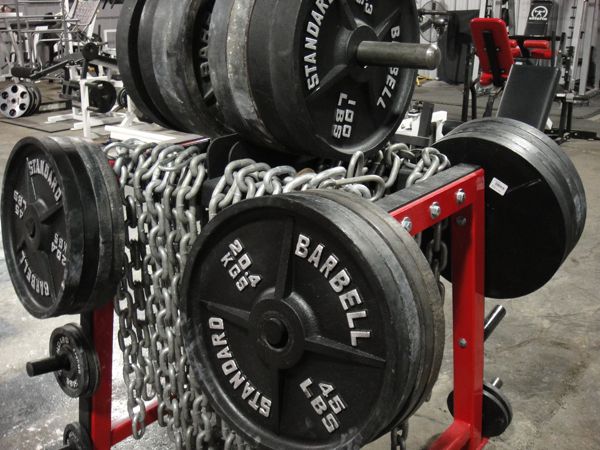
Putting it all together
Because we’ve discussed rep range, volume, and frequency, the only thing left to do is put it all together. There isn’t any “perfect” routine in this article. I’m simply giving you ideas based on what I’ve seen work. So I’ll outline how I might set up a few routines using the principles above.
Week 0: Break in week
Use the first week of the routine below, but don’t use any intensity techniques and leave a couple of reps in the tank on every exercise.
Week 1:
Upper body A, intensity based
Bench presses, work up to a top set of 5–8 all out to failure
Barbell rows, work up to a top set of 5–8 all out to failure
Incline dumbbell presses, 1 X 15–20 reps rest/pause style
Cuff work, 2–3 sets light
Lower body A, intensity based
Squats, work up to a top set of 12–20
Stiff leg deadlifts, work up to a top set of 15
Leg curls, 1 strip set 10/10/10 all to failure
Upper body B, dumbbell, body weight, and machine based, moderate intensity overall
Dumbbell bench presses, 3 sets of 12–15 heavy but leaving a rep or two in the tank
Chins, 30–50 reps in as few sets or as little time as possible
Hammer strength incline presses, 2 straight sets of 8–10 taken to failure
Cuff work, 2–3 sets light
Week 2:
Lower body B, machine and body weight movement based, low intensity
One legged squats or walking lunges, 80–100 total reps
Leg presses, 4–5 sets of 15–20
Glute ham raises, 30 total reps
Repeat upper body A
Repeat lower body A
A very bare bones routine could look like so (and work really well):
Day 1:
Bench, 2 working sets
Dips, 50–100 total reps
Upright rows, 2 working sets
Day 2:
Squats, 2 working sets
Rows, 2 working sets
Chins, 30–50 total reps
Day 3:
Incline, 2 working sets
Press behind the neck or standing military presses, 2 working sets
Side laterals, 2–3 working sets
Day 4:
Deadlifts, 2 working sets
Rows, 2 working sets
Chins, 20–30 total reps weighted
You could rotate these the same way and just try like hell to get as brutally strong using a few sets shy of failure, slowly adding reps or a couple of pounds every week until you stagnate. Then reset those lifts (take around 15 percent off and start over).
These are just example routines, but they could be used as written with great results. There aren’t any curls or isolation triceps exercises, and I don’t have a problem if you wanted to throw something in at the end of the upper body days. I just suggest limiting it to cables and dumbbell work because the meat and potatoes should be the squats, presses, rows, and chins.
The other thing you may notice on the first routine is that I set it up so that you basically do two all out sessions per week. Then you have a moderate or low intensity based day. These days should be “fun” where you get a pump, lube the joints up, and feel better leaving the gym than when you walked in. As I noted, beating the snot out of yourself every single session is a sure fire way to grind your bones to dust in no time. Plus, training should still be fun sometimes, especially on those days when you feel like crap and don’t want to go on.
On the second routine, the majority of the movements are barbell movements, so I’d personally recommend using the “two sets with a few left in the tank” methodology here. Just concentrate on adding a few reps every few weeks or a couple of pounds. A mere two pounds a month on your bench is 24 pounds on your bench in a year. For guys with an already good level of strength, that’s a heck of a nice gain.
So if you’re an intensity guy, the first routine may be more to your liking. If you’re a guy who likes to get a little more volume in, the second routine may be more for you. You still have a little bit of room to play with so try some things out. However, if something is working, don’t fix it. Stick with it until it isn’t.
I also strongly advise listening to your body. If you’re tired but are scheduled to do a high intensity session, take another day of rest and try it the next day. Or do the same movements but go in and do something light as if it were a low intensity day. The longer you can string out the program without burn out or injury, the steadier the gains are going to come. When you do hit a wall, don’t fret about it. Take a week off and have a break before you implement another cycle of this style of training.
I also recommend setting a timeline for how long you will run this program. Set some realistic goals to accomplish in that time such as “gain 10 pounds of lean mass in three months.” Some may scoff at that, but 10 quality pounds is a hell of a lot better than 20 pounds of fat sitting on top of 10 pounds of lean mass. Why? Because when you diet to take off the 20 pounds, most of the 10 pounds of lean mass will go with it. Now you're right back where you started. Doesn’t seem too smart, does it?
Other factors
There are two other factors that really matter when it comes to training program results—your “buy in” and lifestyle. If you think a program is the holy grail of training programs, you’ll probably make great progress. If you don’t buy that the training program is good, you’re probably not going to make very good progress. My advice is to buy into a philosophy rather than a training “style” or “program.” In other words, my own philosophy is as so...
- Add more reps or weight to the bar, a little bit at a time over the long haul.
- Train hard with a low to moderate amount of volume.
- Stick with a few select movements you can do pain free that give a lot of bang for their buck.
- Press big weights overhead, pull big weights off the floor, and squat.
- Get as strong as hell at moving your body through space (dips, chins, push-ups, lunges).
- Perform injury prevention with one-legged movements, rotator cuff work, foam rollers, and stretching.
- Do hard conditioning a few times a week.
This is my philosophy of training. This covers everything I need to know. I can lay all of these things out in a million templates, but what doesn’t change is the philosophy of what I believe works and has worked for people for decades. Just like gaining mass can come down to inserting a few peanut butter and jelly sandwiches into your diet, training is simple. The effort required is the hard part.
The other factor is lifestyle. If you’re getting drunk every night and hung over the next morning, how the hell are you going to train hard on a consistent basis? You can’t. Spare me the crap. If you’re staying up all hours of the night, when is your body going to get the rest it needs to recover? It isn’t. Make lifestyle choices and sleep a priority. I'm not saying that you can’t have a beer now and then. I enjoy a good drink myself. But just like a cheat meal when you’re dieting, earn those moments. Put as much focus on recovery as training and reap the rewards.
And finally, let me add that once you embark on a mass gaining quest and are lucky enough to have all the stars align, don’t mess with anything. If you’re gaining at a nice clip of a pound every 7–10 days, your strength is climbing, and you feel good, don’t mess with anything. I liken it to drag racing. A guy works for a long time to take his ride up to 700 horsepower. He forges all of the internals, replaces his transmission to handle the torque, gets his gear ratios perfect, puts some fat meats on the back, and hits the track. He runs the fastest time ever and then goes home and figures out how to get faster. He takes his car up to 800 horsepower, goes back to the track, takes off, and blows everything to hell in a hand basket.
Sometimes things are as good as they’re going to get and you’re already doing everything as perfect as it’s going to get. So if gains are coming in at a steady clip, don’t be greedy. It’s hard enough to make progress doing this as is. Don't mess with a good thing. Now go make some peanut butter and jelly sandwiches.









